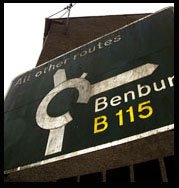Say Goodbye to the Murals of Belfast
by ARIELLE EMMETT, special to the Armagh Examiner
 BELFAST, AUGUST 1. The Northern Irish government has promised the country that all graphic reminders of the troubles will be washed away.
BELFAST, AUGUST 1. The Northern Irish government has promised the country that all graphic reminders of the troubles will be washed away.In Derry this week, a pink mural welcoming the world to gay and lesbian Derry was half painted over. On Tuesday, July 31, the last of the British forces shipped out of Northern Ireland for Afghanistan, symbolically the end of British occupation and the start of peace. And in West Belfast, the paramilitary murals painted on Protestant and Catholic neighborhood buildings are about to be white washed forever. “After next week the murals will be gone,” said Margaret McAliskey, our Irish Culture and History professor of The Armagh Project. She made a scrubbing gesture with her hand, as though wielding a paint brush or mop. “You’ll not see them again. They’ll be painted over,” she said.
Seems this is the Northern Irish government’s plan to help paint over the wounds of 30 years of war. Curiosity got to us; the idea of painting over the collective history of a people seemed strange. So on Sunday morning, July 29, Professor Susan Jacobson and I caught the bus to Belfast. On our arrival, we encountered a city bus tour guide who ignored us while he whipping out a pack of tickets for a group of visiting Yankee businessmen. We stood in line, and when he refused to answer our questions about his tour, we left. Meeting him was a fairly creepy introduction to the city.

Our next encounter was more fortunate. We grabbed a “black taxi” (actually painted silver) to visit the murals. Our cab driver, Robert Beattie, patiently guided us through the social history of thirty years of bitterness. He drove us along both sides of the “Peace Line,” actually a graffitti-strewn concrete and iron wall festooned with thousands of signatures – including President Bill Clinton’s. The Peace Line separates the Protestant district of Shankill Rd. and the Catholic district known as The Falls. On each side of the wall, you can see a distinct record of the troubles in popular art – cartoonish murals of William of Orange and Oliver Cromwell, a hero to the Ulster loyalists; a bleeding red hand, symbolizing “The Red Hand of Ulster,” and some expertly drawn and sinister portraits of young commandos and other paramilitary types from the UFF (Ulster Freedom Fighters) and the Ulster Volunteer Force (another loyalist group). Many of the commandos are wearing black head socks and carrying machine guns. Text accompanies the murals commemorating fallen heroes and innocent victims of the bloodshed.
On the Catholic side, the murals depict most famously the hunger strikers, especially Bobby Sands, a poet and elected Member of Parliament who was the first to starve himself to death protesting the treatment of Catholics. One of his most famous lines, “Our revenge will be the laughter of our children,” is written on the mural walls. There is also a stone memorial set inside a tiny garden within the well-kept Falls Catholic estate. The stones are inscribed in Gaelic with the names of Republican fallen from 1916 to the present day.
I was struck by the bleakness of the Shankill estates especially. In the middle of the road of one residential neighborhood, there is a tire graveyard, with heaps of garbage and scraps of metal piled up. Beattie, our guide, said the people here routinely set bonfires at the site, but the area will shortly be cleaned up. The estate still gives off the aura of an armed camp. The murals here are painted both in color and black and white; they are eerie and monumental reminders, and Irish children play in front of them. Some portray scenes from both IRA and Loyalist bombings and sniper fire; others are divided up like comic strips, depicting several scenes of anguish and the death of babies wrapped in swaddling clothes.

On both the Catholic and Protestant sides, it’s easy to see the anger here, but also the art of an anguished people. It seems hard to believe that the government is now going to white wash these records of history and replace them with more homogenous and “healing” imagery such as Northern Ireland’s sporting heroes.
“I was born in Shankill where a lot of innocent people have died,” Beattie said. “Hopefully they [the government] will take the Peace Line down, block by block, and then restore it. At least some of it should stay up as a memorial. If they take it down in a block, they should put it in a Peace Museum.”
We feel the same way about the murals. It’s clear that the mood here is to succor the population while encouraging a new era of healing and bipartisanship. But the ‘painting over’ program seems shot gun and short-sighted, as though the government is erasing a memory tape. The program certainly does not have the support of many residents of Belfast; the white wash program suggests the presence of an Orwellian Minister of Culture, Big Brother.
How can the Northern Irish forget that those who don’t learn from history are doomed to repeat it?
Arielle Emmett is professor of storytelling in the Armagh Project.
